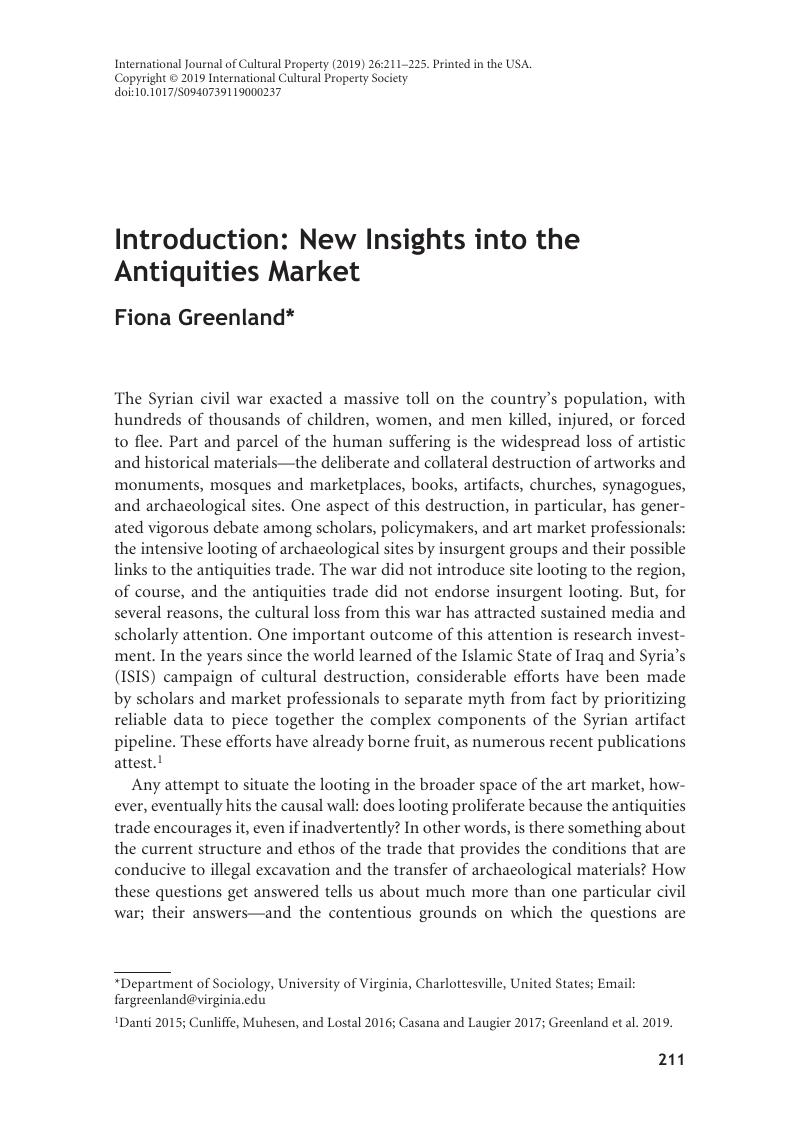No CrossRef data available.
Article contents
Introduction: New Insights into the Antiquities Market
Published online by Cambridge University Press: 02 September 2019
Abstract
An abstract is not available for this content so a preview has been provided. Please use the Get access link above for information on how to access this content.

- Type
- Article
- Information
- Copyright
- Copyright © International Cultural Property Society 2019
References
BIBLIOGRAPHY
Beckert, Jens, and Aspers, Patrik, eds. 2011. The Worth of Goods: Valuation and Pricing in the Economy. New York: Oxford University Press.CrossRefGoogle Scholar
Bowman, Blanche A. 2008. “Transnational Crimes against Culture: Looting at Archaeological Sites and the ‘Grey’ Market in Antiquities.” Journal of Contemporary Criminal Justice 24, no. 3: 225–42.CrossRefGoogle Scholar
Brodie, Neil. 2019. “Through a Glass, Darkly: Long-Term Antiquities Auction Data in Context.” International Journal of Cultural Property 26, no. 3: 265–283.Google Scholar
Campbell, Peter. 2013. “The Illicit Antiquities Trade as a Transnational Criminal Network: Characterizing and Anticipating Trafficking of Cultural Heritage.” International Journal of Cultural Property 20: 113–53.CrossRefGoogle Scholar
Casana, Jesse, and Laugier, Elise Jakoby. 2017. “Satelle Imagery-Based Monitoring of Archaeological Site Damage in the Syrian Civil War.” PLOS One 12, no. 11: e0188589. https://doi.org/10.1371/journal.pone.0188589CrossRefGoogle ScholarPubMed
Cunliffe, Emma, Muhesen, Nibal, and Lostal, Marina. 2016. “The Destruction of Cultural Property in the Syrian Conflict: Legal Implications and Obligation.” International Journal of Cultural Property 23, no. 1: 1–31.CrossRefGoogle Scholar
Danti, Michael. 2015. “Ground-Based Observations of Cultural Heritage Incidents in Syria and Iraq.” Near Eastern Archaeology 78: 132–41.CrossRefGoogle Scholar
FitzGibbon, Kate, ed. 2006. Who Owns the Past? Cultural Policy, Cultural Property, and the Law. New Brunswick, NJ: Rutgers University Press.Google Scholar
Fourcade, Marion. 2011. “Cents and Sensibility: Economic Valuation and the Nature of ‘Nature.’” American Journal of Sociology 116, no. 6: 1721–77.CrossRefGoogle Scholar
Gerstenblith, Patty. 2019. “Provenances: Real, Fake, and Questionable.” International Journal of Cultural Property 26, no. 3: 285–304.Google Scholar
Greenland, Fiona, Marrone, James, Topçuoğlu, Oya, and Vorderstrasse, Tasha. 2019. “A Site-Level Market Model of the Antiquities Trade.” International Journal of Cultural Property 26: 21–47.CrossRefGoogle Scholar
Hixenbaugh, Randall. 2019. “The Current State of the Antiquities Trade: An Art Dealer’s Perspective.” International Journal of Cultural Property 26, no. 3: 227–238.Google Scholar
Kersel, Morag. 2008. “The Trade in Palestinian Antiquities.” Jerusalem Quarterly 33: 21–38.Google Scholar
Kersel, Morag M., and Hill, Austin (Chad). 2019. “The (W)hole Picture: Responses to a Looted Landscape.” International Journal of Cultural Property 26, no. 3: 305–329.Google Scholar
Lyons, Claire. 2016. On Provenance and the Long Lives of Antiquities. International Journal of Cultural Property 23: 245–53.CrossRefGoogle Scholar
Mackenzie, Simon, and Yates, Donna. 2017. “What Is Grey about the ‘Grey Market’ in Antiquities?” In The Architecture of Illegal Markets: Towards an Economic Sociology of Illegality in the Economy, edited by Beckert, Jens and Dewey, M., 70–86. Oxford: Oxford University Press.Google Scholar
Marlowe, Elizabeth. 2013. Shaky Ground: Context, Connoisseurship and the History of Roman Art. London: Bloomsbury Academic.Google Scholar
Merryman, John. 1986. “Two Ways of Thinking about Cultural Property.” American Journal of International Law 80: 831–53.CrossRefGoogle Scholar
Rothfield, Lawrence. 2019. “The Past Polluted: A Pigovian Approach to the Black Market in Antiquities.” International Journal of Cultural Property 26, no. 3: 343–355.Google Scholar
Schindler, Hans-Jakob, and Gautier, Frederique. 2019. “Looting and Smuggling of Artifacts as a Strategy to Finance Terrorism Global Sanctions as a Disruptive and Preventive Tool.” International Journal of Cultural Property 26, no. 3: 331–342.Google Scholar
Thompson, Erin. 2016. Possession: The Curious History of Private Collectors. New Haven, CT: Yale University Press.Google Scholar
Topçuoğlu, Oya, and Vorderstrasse, Tasha. 2019. “Small Finds, Big Values: Cylinder Seals and Coins from Iraq and Syria on the Online Market.” International Journal of Cultural Property 26, no. 3: 239–263.Google Scholar
Van Laar, Timothy, and Diepeveen, Leonard. 2013. Artworld Prestige: Arguing Cultural Value. Oxford: Oxford University Press.Google Scholar
Velthuis, Olav. 2011. “Damien’s Dangerous Idea: Valuing Contemporary Art at Auction.” In Beckert, and Aspers, , The Worth of Goods, 178–200.Google Scholar
Zelizer, Vivana. 2004. “Circuits of Commerce.” In Self, Social Structure, and Beliefs, edited by Alexander, Jeffrey, Marx, Gary T., and Williams, Christine, 122–44. Berkeley: University of California Press.Google Scholar




